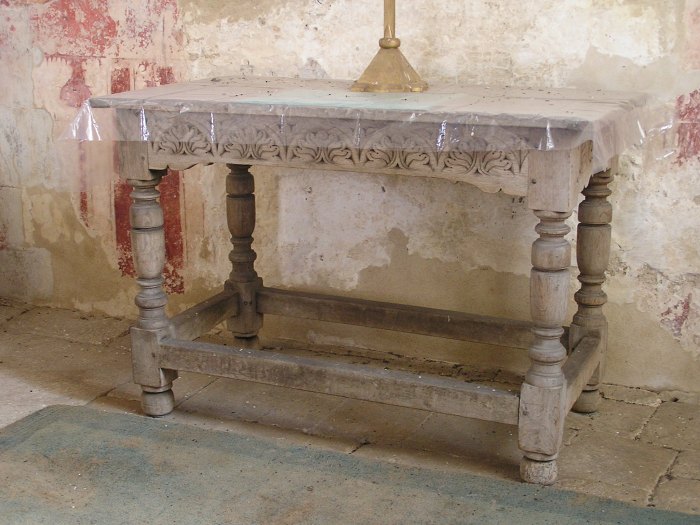I often get emails in addition to the comments posted on the blog…some with questions, others just wanting to contact me about furniture, tools, woodworking, etc. Thanks & keep ’em coming, I say.
Today I got a very nice note from Olde England …a reader of this blog James Rayner, wrote to say that it had “led me to explore a type of woodworking previously unknown to me and its a style I have fallen in love with.”
AND, then James sent several photos from a small village church near his home in Suffolk.


There was no need for James’ apology about the photos, it’s hard to shoot in those village churches. But well worth it, they are a treasure. So, James – thanks for sending the photos along. As I said in my reply to James this morning, isn’t it great to have a crash course in joined work just 2 miles from his house, & he can go right in & sit down…
When I first visited some of the redundant churches in the south of England, I couldn’t comprehend it. There is no reference point for it here in New England. The feeling I got walking into such an old building…it felt like some seventeenth-century church-goers had just left & closed the door…and with their many layers of history, these churches are an unbelievable area of study.
I shot some stuff years ago with Victor Chinnery in Wiltshire. The color of the oak in the churches is different from domestic stuff, I think because of the lack of a fire…all that smoke darkens the wood & finish. Here’s a table I saw, sitting in essentially one spot for over 300 years.

There’s a group that has been working for years with these old buildings, doing preservation and restoration. Here’s their website:
http://www.visitchurches.org.uk/
While on the subject of Suffolk, a book I have really enjoyed is Birkin Hayward’s ‘Suffolk Medieval Church Roof Carvings‘. Stuff is unreal. Makes me want to go to Suffolk, where my mother’s family emigrated from in the 1630s.
Some day.
Hi Peter,
I’ll second your recommendation for Hayward’s book, good stuff.
Also on the subject of Suffolk churches is this website: http://www.suffolkchurches.co.uk/Alist.htm
The author has so far visited and photographed 654 churches in Suffolk and also added a brief history to each church. He has also undertaken a similar project for Norfolk: http://www.norfolkchurches.co.uk/
Think it is Birkin Haward: his son, also BH is an architect in London making modernist buildings but with an eye to his East Anglian roots. Makes wonderful drawings of architecture and its details.
Makes me think of “Church-Going” by Philip Larkin.
Hello,
This is a desperate cry from the heart for free advice.
The doors of our church are coated with an architect advised, black, water based, paint.
It is degrading and falling off, to give the effect of rapidly advancing alopecia, and looks dreadful.
I have now been advised by a woodworker, that the only suitable treatment for ancient, exterior
oak, should be boiled linseed oil.
There is some rot at the bottom, where water has bypassed the paint, which I can treat and hide, without too much difficulty, but how on earth can I make the doors look less like a long deserted and neglected entrance to a bankrupt junk yard?
I’m afraid that simply stripping the paint and leaving a weathered appearance is out of the question. They are too dilapidated for that option.
I do hope that you can advise. Apologies for the impertinence of my approach.
Sincerely,
John M Campbell
John
I am way behind on picking up on Follansbee’s blog so please fogive me for responding so long after your post. If your doors are still a problem you might want to take a look at this link
http://www.regionalfurnituresociety.com/care_of_church_furniture.htm
Chris